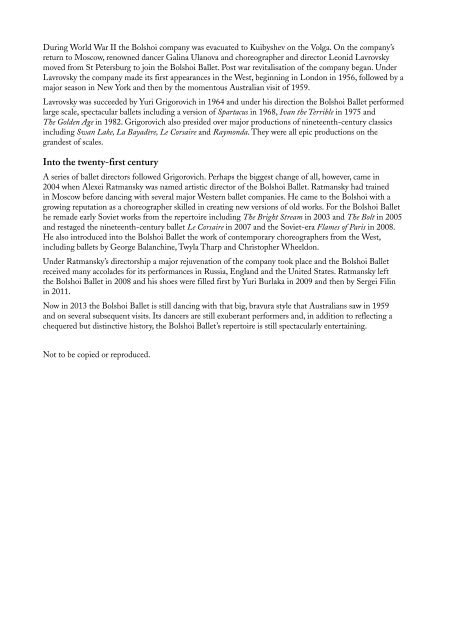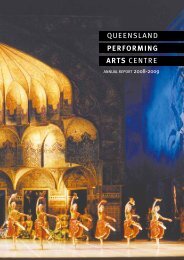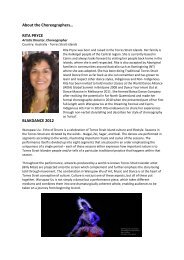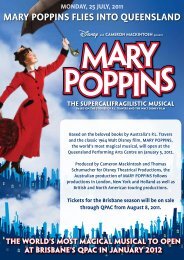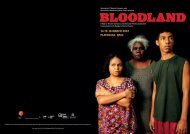Download - QPAC
Download - QPAC
Download - QPAC
Create successful ePaper yourself
Turn your PDF publications into a flip-book with our unique Google optimized e-Paper software.
During World War II the Bolshoi company was evacuated to Kuibyshev on the Volga. On the company’s<br />
return to Moscow, renowned dancer Galina Ulanova and choreographer and director Leonid Lavrovsky<br />
moved from St Petersburg to join the Bolshoi Ballet. Post war revitalisation of the company began. Under<br />
Lavrovsky the company made its first appearances in the West, beginning in London in 1956, followed by a<br />
major season in New York and then by the momentous Australian visit of 1959.<br />
Lavrovsky was succeeded by Yuri Grigorovich in 1964 and under his direction the Bolshoi Ballet performed<br />
large scale, spectacular ballets including a version of Spartacus in 1968, Ivan the Terrible in 1975 and<br />
The Golden Age in 1982. Grigorovich also presided over major productions of nineteenth-century classics<br />
including Swan Lake, La Bayadère, Le Corsaire and Raymonda. They were all epic productions on the<br />
grandest of scales.<br />
Into the twenty-first century<br />
A series of ballet directors followed Grigorovich. Perhaps the biggest change of all, however, came in<br />
2004 when Alexei Ratmansky was named artistic director of the Bolshoi Ballet. Ratmansky had trained<br />
in Moscow before dancing with several major Western ballet companies. He came to the Bolshoi with a<br />
growing reputation as a choreographer skilled in creating new versions of old works. For the Bolshoi Ballet<br />
he remade early Soviet works from the repertoire including The Bright Stream in 2003 and The Bolt in 2005<br />
and restaged the nineteenth-century ballet Le Corsaire in 2007 and the Soviet-era Flames of Paris in 2008.<br />
He also introduced into the Bolshoi Ballet the work of contemporary choreographers from the West,<br />
including ballets by George Balanchine, Twyla Tharp and Christopher Wheeldon.<br />
Under Ratmansky’s directorship a major rejuvenation of the company took place and the Bolshoi Ballet<br />
received many accolades for its performances in Russia, England and the United States. Ratmansky left<br />
the Bolshoi Ballet in 2008 and his shoes were filled first by Yuri Burlaka in 2009 and then by Sergei Filin<br />
in 2011.<br />
Now in 2013 the Bolshoi Ballet is still dancing with that big, bravura style that Australians saw in 1959<br />
and on several subsequent visits. Its dancers are still exuberant performers and, in addition to reflecting a<br />
chequered but distinctive history, the Bolshoi Ballet’s repertoire is still spectacularly entertaining.<br />
Not to be copied or reproduced.


